A mezcal tasting is a beautiful thing. I hope you have your chance. I interspersed quotes from some of my favorite authors throughout this essay in the hope of inspiring you to grab at the opportunity should it arise.
Qué bonito y qué bonito How nice, I say how nice, es brindar por una ingrata, to toast the standoffish one, y a los 15 o 20 tragos and after fifteen or twenty drinks llevarle una serenata. go and give her a serenata. Roberto Bolano, The Savage Detectives.

Over the past ten years, mezcal has extended its market around the world. In the United States, mezcal is now a popular choice in upscale restaurants that a few years ago thought of it as no more than Mexican moonshine. I am an aficionado, a lover, an ecstatic devotee of mezcal as much as any religious convert could be. Yet, I am no more than a novice, an initiate into the complex and still changing mezcal world. What I offer here is a small paean in appreciation of mezcal in the hope that you might come to understand why it is emerging as a significant beverage hoping that you might venture to try it yourself assuming you are able to drink alcohol. In no way do I wish to encourage drinking for anyone opposed to it or addicted to alcohol or abusive under the influence. My personal philosophy, everything in moderation, works for me but may not work for all.
She immediately brings out the mezcal or makes a steaming pot of spiked coffee sweetened with condensed milk that comes gushing out of the can, and if they can pay her, fine, and if not, they’ll drop by with the dough when they can. Elena Poniatowska, Slide in, my dark one, Between the Crossrie and the Whistle
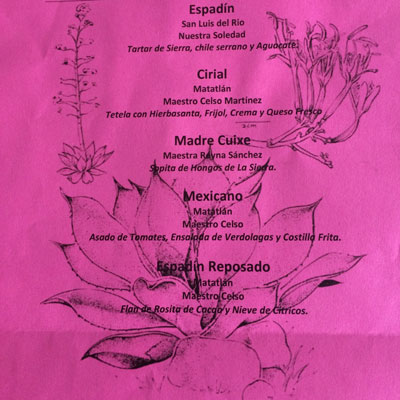
What’s the best way to taste mezcal? Del Maguey’s Ron Cooper has this advice: “Take the tiniest sip you can possibly take and squeeze your tongue into the roof of your mouth and into the front of your teeth and the mezcal will go to the back of your tongue and over your palate and down the throat. Wait 30 seconds before taking another sip, and your palate will be awakened. After that, sip normally and the mezcal will be softer and sweeter. Once you’ve consumed mezcal three or four times, you won’t have to tune up your palate, because you’ll know what you’re expecting. The motto is: Sip it. Don’t shoot it.”
As I’ve heard serious mezcal drinkers say, mezcal should be “kissed, not shot.”
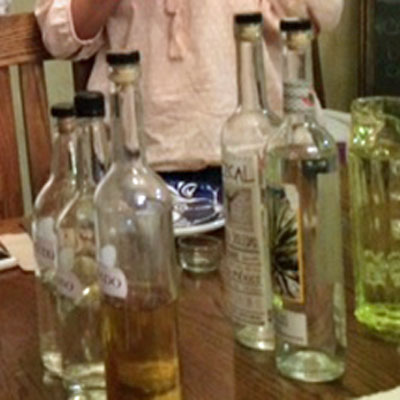
Mezcals we tasted
Pilar Cabrera, owner of La Olla Restaurant in Oaxaca, Mexico, chef of passion, ambassador to the world for the indigenous, original and authentic tastes of Oaxaca tells me that the best way to learn about, understand, and appreciate mezcal is to taste it with carefully chosen foods grown in the same area where the agave (maguey) is grown from which the mezcal is produced. I know in my heart that she’s right. I know because I participated in one of her mezcal and food pairings where mezcal came alive for me in new and different ways.
While you are reading this, you might want to listen to how mezcal sounds. Yes, a guitar duo has been composed with “music that can be as hallucinating as mezcal” and you can listen at THIS LINK.
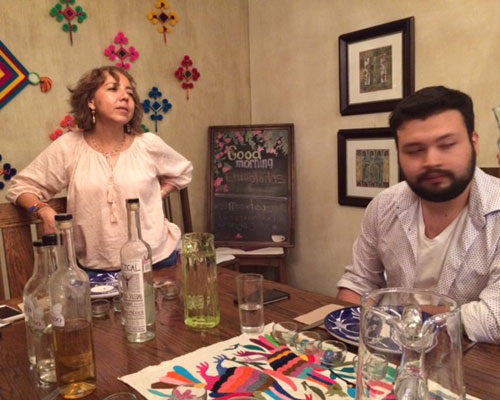
Pilar and Danielle
I first tasted mezcal in Oaxaca several years ago at a local mezcal bar named Mezcaloteca just a couple of blocks up Reforma street from La Olla Restaurant. That was when I first heard the phrase: “Para todo mal, mezcal, y para todo bien, también.” (“For every ill, Mezcal, and for every good as well.”).
What I immediately understood at the time was that the flavor of mezcal, like wine, arises from the individual terroir: geology, soil, vegetation, topography, weather, water, and air and from the distinctive methods used by the mezcalero, the distiller, whose personal artistic style makes every mezcal unique.
I was with these boys and they have some mescal and everything—you know what is mescal?—and there was this woman and all these boys is go out to this woman and they is have this woman. And I am the last one. And I go out to the place where is this woman and she is refuse me because she say I am too young or something like that.
Cormac McCarthy, All the Pretty Horses
What I did not sufficiently appreciate, not until quite recently in fact, was how food and mezcal interact to create a total aesthetic experience. Look, I’m not a foodie. I like all well prepared foods from the street foods of Mexico up to the pricy alternatives. Mezcal, although increased demand is driving up prices, is still available to the average person.
Let me clear up one minor point before continuing—the spelling. Mezcal or Mescal? I prefer mezcal. When I see mescal I automatically think of mescaline, the psychedelic drug derived from peyote and certain other cacti. I have never seen a bottle of mezcal with the “s” used in place of the “z”. You can read an informal discussion of this HERE. If you spell mezcal with a “z” as I do, your spell check program will try to change the “z” into an “s”. Don’t allow that. Tell whoever designed that stupid spell check program to fix it. Please.
He learned to mix mortar, lay brick, and drink mezcal to the point of no return. It took Hector only a few months to earn his macho badge of honor. Daniel Reveles, Salsa and Chips
And now, the easiest thing for me to do at this point would be to tell you to book a trip to Oaxaca, to go directly to La Olla Restaurant on Reforma Street near the beautiful Santo Domingo Church, to sign up for the very next mezcal and food pairing by Pilar, and to relax, listen, observe, and taste.
For those of you who cannot do this and want the vicarious experience, I will take you through the tasting Pilar provided for me.
The tasting was very small. I was honored to be there. It may have been my good luck or it may be that I’ve stayed at La Casa de las Bugambilias every year for the past ten years and am now a true friend of the family. Whatever it was, I am grateful.
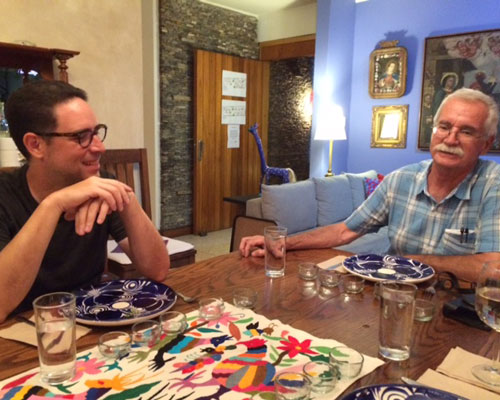
Adrian and Alvin
Diaz finished his drink in a single gulp and stood up. The burn of the mezcal reminded him of the mentholated chest rub his mother had abused him with whenever the flu laid him low. Jonathan Woods, A Death in Mexico
Pilar conducted the tasting. Her superb chef, Alexander Navas Martinez, prepared the food. They were assisted by one waiter from La Olla, Joaquin Sanchez, who served our small group. The attendees included Joaquin Garcia, a highly acclaimed local baker who just opened a new shop near the corner of Pino Suarez and Constitution, Alvin Starkman whose knowledge of mezcal and the local area is a treasure for any tourist hoping to know more about the “real” Oaxaca, Hector Velasco Radilla the bar manager for La Olla, Adrian and Eta Rodriguez, and my wife and I.
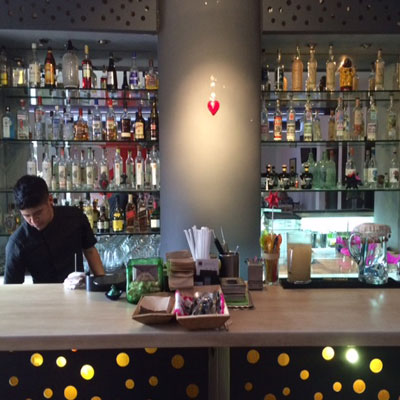
Hector behind the La Olla Bar
That evening, there was much merrymaking at the dance, and a great quantity of mezcal was drunk. Mariana Azuela, The Underdogs
The first mezcal we tried was one of the most common and least expensive mezcals in Oaxaca, Espadin. If you order a mezcal without a specifying a name in most bars and restaurants, you will almost certainly be served Espadin. This particular bottle was produced in San Luis del Rio, a small village two hours outside the city. I find Espadin less smoky, softer, and easier to drink than many of the alternatives.
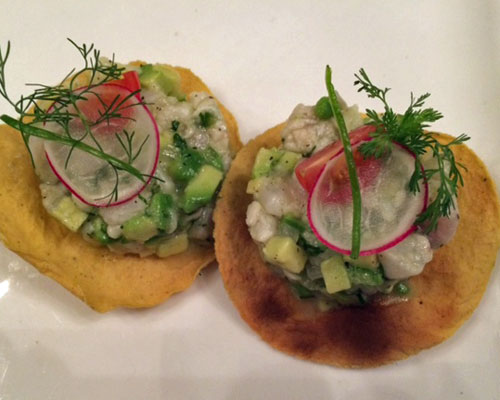
Tartar de Sierra, chile Serrano y Aguacate
Pilar suggested, for each mezcal, to smell it, to put a tiny bit on the tongue and roll it around in the mouth, then to take a small sip. Lastly, eat the appetizer served with the mezcal and taste it again noting the difference. With the Espadin, we were served Tartar de Sierra, chile Serrano y Aguacate. This was ceviche served on a small, thin, crisp tortilla. I think the fish was swordfish. The size of each appetizer was equivalent to one or two bites, no more. Pairing the Espadin with the ceviche brought out a new complexity in the mezcal. I think for those who drink fine wines, there is a similar experience.
“In the dark he felt for the bottle of mezcal. But it would not serve forgetfulness but to quicken memory. He would return to the beach and the rocks while the white alcohol burned inside him…. Liquor was good for the exploding of lies, pretty lies” Carlos Fuentes, The Death of Artemio Cruz
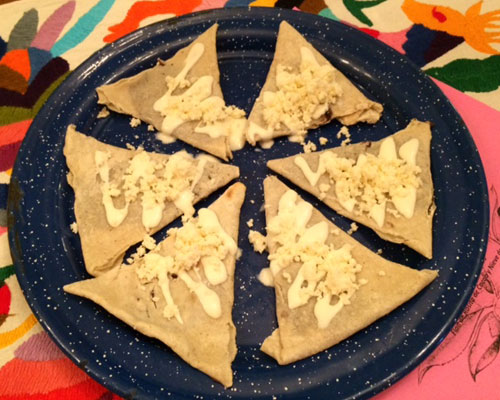
Tetela con Hierbasanta, Frijol, Crema y Queso Fresco
The second mezcal was a Cirial. The difference was dramatic. Cirial is quite herbaceous and it seemed to me stronger in taste. A comparison I might offer between Espadin and Cirial is like the difference between a crisp Soave and a grassy Sauvignon Blanc although others might differ in their opinion. The Cirial we sipped was from Matatlan. Also known as Santiago Matatlan, this small village lies in the Tlacolulu valley about an hour and half outside the city and is known for its excellent mezcals. Like all mezcals, this Cirial displays the unique style of the mezcalero, Maestro Celso Martinez. We were served Tetela con Hierbasanta, Frijol, Crema y Queso Fresco. These are small tortilla triangles with cream and fresh cheese. I found the Cirial pungent and stronger than the Espadin, spicier and brighter.
Next we tried a Madre Cuixe by Maestra Reyna Sanchez, one of a growing number of female mezcaleras who produces her mezcal at San Luis Amatlan. You can read about her at one of my favorite mezcal online sites, Mezcalistas, CLICK HERE.
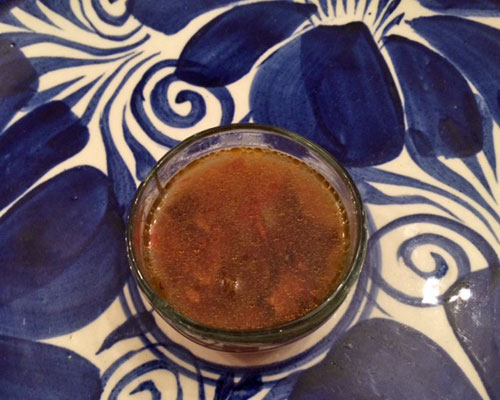
Sopita de Hongos de Sierra
The Madre Cuixe had a mineral or chemical taste, but that did not detract from my enjoyment. I also found it quite strong. I envisioned Reyna as a strong and powerful woman, not to be messed with, just like her mezcal, but of course I don’t know her and it was only my imagination working with the mezcal to create this picture in my mind. Her mezcal was paired with Sopita de Hongos de Sierra, a tiny cup of delicious mushroom soup. At this time of year the mushrooms are fresh and abundant around Oaxaca during the rainy season and the earthy flavors of the mushrooms compliments the powerful Madre Cuixe as if a king to a queen. (Yes, I’m getting carried away now. The mezcal is having its way with me.)
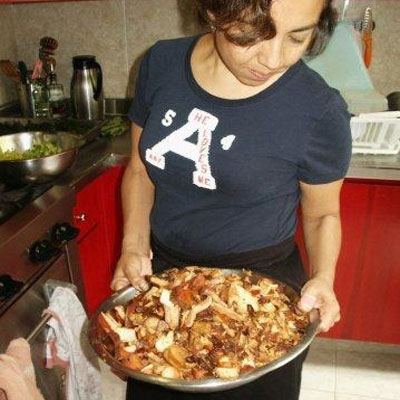
Chef Pilar Cabrera with tray of mushrooms for soup
We come now to a Mexicano, also from Matatlan and by the same Maestro Celso. I rebounded from my first taste. I did not find it pleasant at all. It had a peculiar flavor that I did not like. However, after it was paired with Asado de Tomates, Ensalada de Verdolagas y Costilla Frito (a tiny fried pork bite with a little salad on a roasted tomato sauce), things completely changed. I found it delicious, spicy, complex. The Mexicano and the pork bite worked perfectly together, like a key that found the right lock.
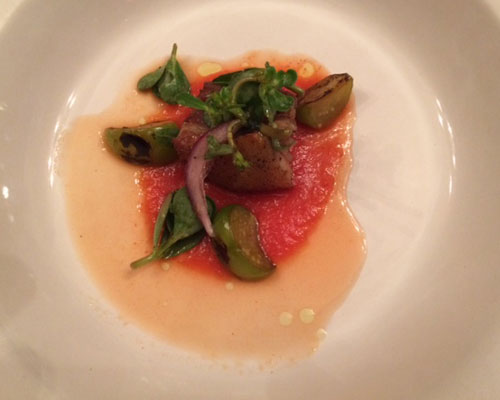
Asado de Tomates, Ensalada de Verdolagas y Costilla Frito
Many famous writers have mentioned mezcal. Malcolm Lowry called it habanero. Unfortunately, he was an inveterate drinker who did not know when to stop. He did manage to write one of the best novels in the English language in spite of that.
“How’s the mezcal?”
“Like ten yards of barbed wire fence. It nearly took the top of my head off.”
Malcolm Lowry, Under the Volcano
“We stopped at a cantina, and had some mezcal — the driver told me it was good for dysentery. I don’t think it was, but it was good for our spirits.” Graham Greene while in Oaxaca
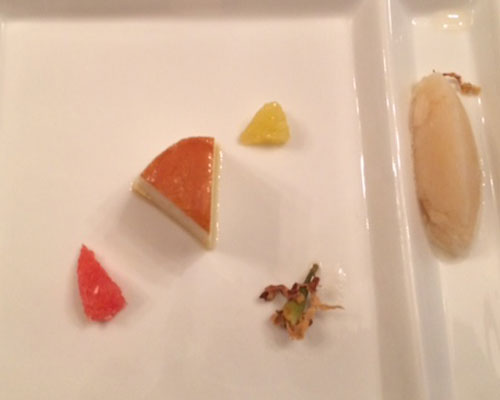
Flan de Rosita de Cacao y Nieve de Citricos
At the end of the tasting, we tried another Espadin This time it was a Reposado which means aged. The aging process considerably softens the mezcal and sweetens it. Once again, this was produced by Maestro Celso in Matatlan. The Reposado was paired with dessert, a flan made with a distinctive local flour that has strong maple overtones. I prefer the joven (young) clear mezcals to the reposados. I like their sharp, smoky tastes and spicy aftertaste. However, I must say that a reposado is an excellent pair with the right dessert. I now have much more respect for this aged mezcal that would stand up to any good bourbon or cognac.

Shelf of Mezcals in La Olla Bar
The Reposado marked the end of the tasting. I felt I had hardly scratched the surface. As the market for mezcal grows exponentially, so do the sources of information, many online. I recommend Alvin Starkman’s small book as a starting point and the website Mezcalista. From there, you will easily find your way on your own.
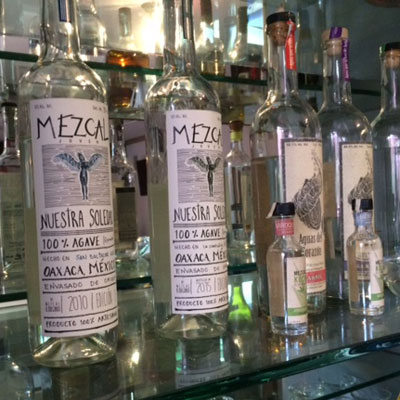
Shelf of Mezcals in La Olla Bar
“Drink up, boys, drink up and don’t worry, if we finish this bottle we’ll go down and buy another one. Of course, it won’t be the same as the one we’ve got now, but it’ll still be better than nothing. Ah, what a shame they don’t make Los Suicidas mezcal anymore, what a shame that time passes, don’t you think? what a shame that we die, and get old, and everything good goes galloping away from us.” Roberto Bolano, The Savage Detectives

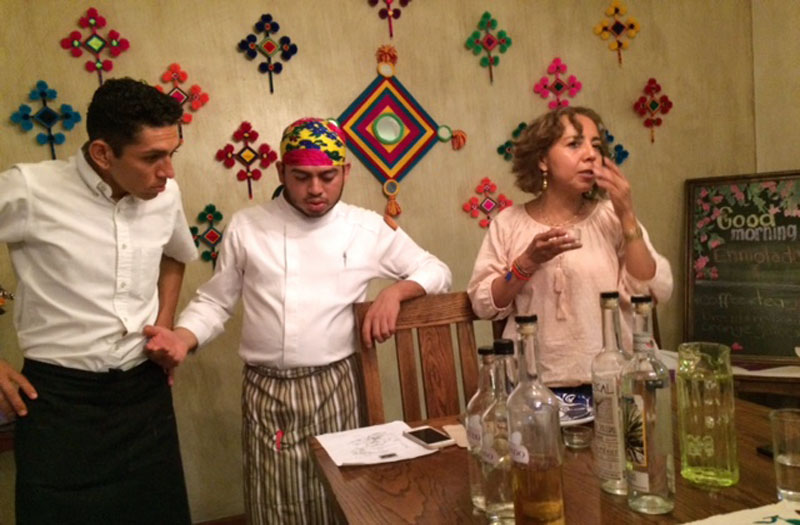
David, thanks for the great description of Mezcal and food pairing. By the way, when I first wrote Mezcal in your blog with a z, it changes to s.
Terry, you are a good friend to read my ramblings. Mezcal, in moderation and paired with good food makes me happy.
What a wonderful melding of literary with an appreciation of the magic of mezcal and its ability to enhance Oaxacan cuisine. Bravo!
Thank you Alvn. Your opinion means a lot.
Some well-chosen quotes and a good read all-round. I should really read Under The Volcano at some point.
The mineral or chemical taste you attribute to the Madre Cuixe is a hard one to put a finger on, for me; I find all mezcals made from a member of the karwinskii family of agaves (and thanks to Alvin Starkman for pointing out which agaves comprise that most interesting branch of the family tree) tend to have a similar twang that I have difficulty describing. My first Madre Cuixe – at Los Danzantes in Oaxaca about 3 years ago – was quite an eye-opener. I’ve been drinking a Bruxo Barril of late which reminds me of it a lot.
Salud!
Bob, thanks for reading and commenting. You are right about Alvin Starkman. His knowledge in this area is exceptional and he is a great teacher.
Thanks for sharing your thoughts of this fascinating world of Mezcal. I am a recent convert to this incredible spirit and find myself drawn to it inexplicably. I found a wonderful Tepestate in Puerto Vallarta a few days ago at a fine restaurant that specializes in Mezcal’s. I want to learn more and to visit the region soon to expand my knowledge. I had a taste of a Tobala by El Jorgario in Pasadena recently which started me along the path. Garcias!
Thank you Chris for taking the time to send a comment. I’ve been drinking mezcal for a few years now and am an ardent fan. You will be too. Keep it up, in moderation of course. David
Shouldn’t there be a photo of you and Flurry in there somewhere?
Just sayin…..